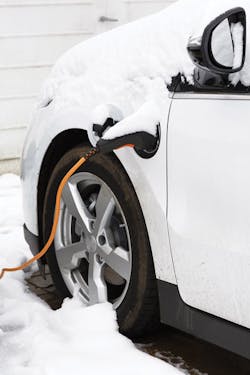Article 625 provides the installation requirements for conductors and equipment that connect an electric vehicle to an electric supply. But before we move on, let’s make it clear what type of vehicles this part of the Code is focused on. A golf cart is a type of vehicle and it’s electric, so does Art. 625 pertain to golf cart charging systems? No. Golf carts are just some of the types of self-propelled vehicles not covered by Art. 625 (see What’s Not Included?).
So what exactly is an electric vehicle? It’s an automotive-type vehicle for on-road use [625.2]. It’s primarily powered by an electric motor that draws power from a storage battery. Examples include:
• Passenger automobiles
• Buses
• Trucks
• Vans
• Neighborhood vehicles
• Motorbikes
The vehicle’s power scheme may include other power sources (e.g., fuel cell), so plug-in hybrid electric vehicles (PHEVs) are also covered.
Equipment requirements
All but one of the equipment requirements apply to the charging system manufacturer or the vehicle manufacturer. For example, the charging system is limited to a short list of nominal voltages [625.4].
The equipment requirement that applies to the installer is you can use only materials, devices, fittings, and associated equipment that are listed [625.5].
The two requirements just mentioned appear at the end of Part I (general requirements). Part II provides the equipment construction requirements. Meeting them really is the job of those who design and build the equipment rather than those who install it.
But manufacturers can make mistakes and so can specifiers. Before installing equipment, go through Part II to ensure the equipment you’re installing meets the requirements. This step should not take much time. Certainly, it will take less time than ripping out the completed installation and starting over.
Location
Locate the charging equipment such that it can connect to the vehicle using only the supplied charging cable [625.50]. You can’t use any intermediary wiring, such as a custom “extension cord” for this purpose; this must be a direct connection [625.50] using a listed cord or cable [625.5, 625.17]. So a location error can’t be fixed without redoing the installation.
Allow for cable length required to reach not the vehicle but its supply connector. Because the charging cable is short [625.17], the geometry involved in parking the vehicle and orienting its charging connector limits your location choices. If you’ve ever pulled up to a gas pump in a rental car only to realize the filling cap is on the side away from the pump, you can picture this problem.
Make sure this location provides adequate room for storing the coupling means:
• Indoors, 18 in. above the floor.
• Outdoors, 24 in. above grade
What subsection 625.50 doesn’t tell you is to consider ventilation requirements when choosing the location. If ventilation is required, see if an exterior wall is a suitable location that meets the other requirements. The duct work reduction may be substantial. And because the system must take air in from the outside, you should consider what’s going on outside a particular wall. For example, you don’t want the intake vent facing a dumpster.
Breathe in, breath out
About 70% of Part III addresses ventilation for the charging system. Why is this so important, and what are the requirements?
It’s important because batteries produce ignitable gas and the charging system can serve as an ignition source. Also, in residential locations, homeowners may store gasoline for lawn equipment (or other ignitables) in their attached garage. Just nine miles from the EC&M editorial office, a home burned to the ground because a consumer-grade battery charger ignited the fumes from radio flier fuel stored in the garage.
Some charging systems are designed with this sort of problem in mind. They are listed for charging electric vehicles indoors. When they are also marked “VENTILATION NOT REQUIRED” [625.15(B)], you don’t have to provide mechanical ventilation [625.52]. Notice that’s in ALL CAPS; this helps distinguish it from another marking.
If you run into the vent location issues mentioned earlier, this type of charging system may be the best answer.
Unless the charging system is listed for use without ventilation, manufacturers are required to mark it with “Ventilation Required” [625.15(C)]. Notice that this marking is in title case, unlike the ALL CAPS case used for the “NOT” version.
If you don’t see either marking, you’ll need to make one of three choices:
1. Obtain positive verification.
2. Assume the system requires ventilation.
3. Obtain a different, definitely marked system (if you don’t want to provide ventilation).
The ventilation must have both supply and exhaust, and it must be:
• Permanently installed.
• Active; that means you must install a fan.
• Located to take air directly from, and vent directly to, the outdoors.
You can use a positive pressure system only in buildings or areas specifically designed for that purpose [625.52(B)].
How much air does this system have to move? That depends upon the branch circuit voltage and ampere rating. Use Table 625.52(B)(1) or Table 625.52(B)(2) to find the correct value. The difference between these tables is the first is metric, and the second is in U.S. Customary Units. If your fan choices are rated in CFM, use the second table.
The 2014 NEC presents an unfortunate layout problem. It starts Art. 626 on the same page as Table 625.52(B)(1) but places Table 625.52(B)(2) on the next page. This can give the mistaken impression there’s only one table.
As with many tables in the NEC, it’s possible for an application to fall outside the table values. In such cases, you can use the equations in 652.52(B)(2) to calculate the value you need.
The ventilation equipment must be interlocked with the charging equipment so the charger can run only with ventilation running [652.52(B)(4)].
Overcurrent protection
The 125% rule applies to these charging systems, as they are continuous duty (running for 3 hr or more) loads. This means you multiply the maximum load of the EV supply equipment by 125%, then add to that any noncontinuous loads (if also supplied by that circuit) to get your calculated load. You then size your feeder and the branch circuit overcurrent protection device (OCPD) for this calculated load.
Use that same calculated load as the basis for determining the conductor ampacity, just as you would for other types of installations (see examples in Informative Annex D).
Disconnect and supply connection
The disconnect must be lockable in the open position, adhering to the requirements of 110.25.
You must install the disconnect in a readily accessible location if it’s rated more than 60A or more than 150V (to ground) [625.42]. While the NEC permits you to ignore this requirement for smaller systems, good design practices do not. Remember the bad old days when installers could get away with running an outside outlet off the GFCI in the upstairs bathroom?
Supply connections
The rules are new with the 2014 NEC. Obviously, the connection to the vehicle itself must be cord and plug rather than hard-wired. But you can also use cord and plug to connect the charging system to the premises wiring [625.44] if it is one of two types:
1) Intended for use with standard household receptacles (non-locking 2-pole, 3-wire, grounding-type, single-phase, 125V, 15A or 20A).
2) Intended for use with 250V outlets (non-locking 2-pole/3-wire or 3-pole/4-wire, grounding-type, rated not more than 50A).
In the latter case, it must also meet some other requirements, such as a maximum cord length of 6 ft [625.44(B)].
You must permanently wire any other type of charging system, and fasten it in place to the support (e.g., wall or pole).
No callbacks. Callbacks are costly in multiple ways. Your first line of defense is to check the specs. Does the equipment conform to the requirements in Part II? Verify this before you get out your tools. And these types of installations, if not well thought-out, can produce callbacks — even if you comply with every requirement of Art. 625.
Usability issues are major callback risks. Design them out so you don’t have to fix them later. Think of where the charging port on the vehicle will actually be positioned once the vehicle is parked for charging. We used the “gas cap on the wrong side” analogy earlier. Here’s another analogy: Have you ever had to wrestle the fuel hose because you pulled too far past the gas pump? A few inches adjustment in mounting location can make a big difference in usability.
The ventilation intake is another example of careful consideration. Always look for the dumpster on the other side of the wall.
Lamendola is an electrical consultant located in Merriam, Kan. He can be reached at [email protected].
SIDEBAR: What’s Not Included?
Article 625 does not apply to off-road vehicles such as:
• Industrial trucks
• Hoists
• Golf carts
• Airline ground support equipment
• Tractors
• Boats






